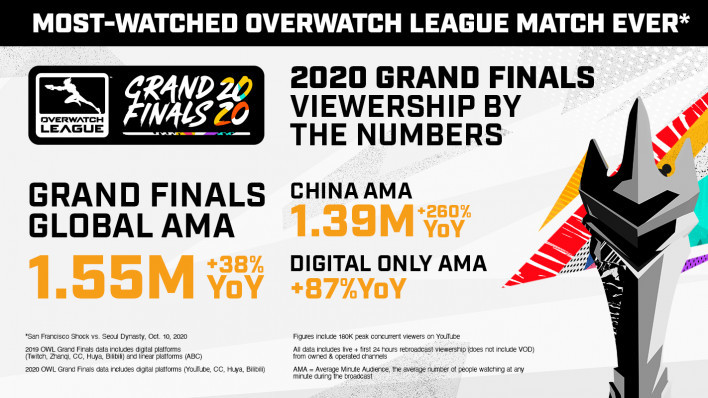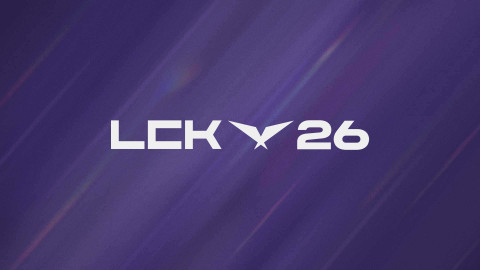
On Tuesday, Oct. 13, Activision Blizzard distributed to the media the official viewership trends for the Overwatch League 2020 grand finals. As San Francisco Shock defeated Seoul Dynasty to win their second title in a row, it became the “most watched Overwatch League match ever” — at least according to Blizzard’s infographic.
These numbers, however, should not be gobbled without a detailed examination, as they misrepresent which direction the OWL is trending. While Blizzard boasts gigantic increases such as a 260% growth in their China AMA (average minute audience), other numbers do not speak so favorably about the league.
AMA, or average minute audience, is a metric used in television, which represents exactly what it says: “the average number of individuals or (homes or target group) viewing a TV channel, which is calculated per minute during a specified period of time over the program duration” (per Nielsen).
For years, Nielsen has worked with both Blizzard and Riot Games to measure AMA for the Overwatch League and the World Championship, respectively. And for past OWL seasons, using AMA made sense. The 2018 grand finals were not just on Twitch, but also on ESPN and Disney XD. The 2019 grand finals headed for ABC.
But for the 2020 grand finals, OWL stayed entirely on streaming platforms. According to Blizzard’s own infographic, the data comes from YouTube (West), and CC, Huya, and Bilibili (China). And when it comes to streaming platforms, esports has long used other metrics to track success — peak and average viewers being the leading ones.
Granted, changing from AMA to another metric just for the 2020 finals is a problem of its own and breaks the consistency that Blizzard is trying to establish. For now, we’ve understood what AMA stands for and why it’s used. Let’s move on.

Blizzard’s official data claims 1.55 million global AMA for the OWL 2020 finals, or a 38% year-over-year (YoY) growth. The China AMA is at 1.39 million, a whopping 260% YoY growth, which would mean a little over 534,000 watched the 2019 finals. Additionally, Blizzard reported 472,000 AMA for the US market, and even broke down the percentage increase for the different demographics, boasting a 13% uptick in the critical 18-34.
For 2020, however, some of that data is missing, which raises several concerns about whether the OWL is really growing.
* * *
First of all, Chinese viewership numbers have been infamously unreliable and unverifiable. Respected data websites in the West, such as Esports Charts, avoid Chinese viewership as a rule, recognizing that this data cannot be trusted with enough confidence. This already puts a serious vote of non-confidence on the OWL 2020 record-claiming numbers, as Chinese viewership has a notable effect on the reported global AMA.
What is ironic here is that a major reason why AMA was introduced as a leading metric for the OWL is that it is, on paper, more accurate and less prone to artificial boosting.
“The reason we use AMA is because it can’t be driven up by embedding,” said Kasra Jafroodi, analysts lead at Blizzard.
“One of the things that’s important to us is that we want to have a pure viewership metric,” Daniel Cherry, chief marketing officer at Blizzard, added. “We want to count every fan who watched and did so credibly.”
With these statements in mind, it is bizarre that Blizzard rests their OWL 2020 viewership claims on a region known for its non-credible, non-pure numbers reporting.
Here, it’s important to point out that there likely was an increase in viewership for the finals weekend when it comes to China, as Shanghai Dragons competed in the playoffs, setting up multiple rivalries and rematches: the May Melee and Asia Playoffs finals rematch against Seoul Dynasty, and the 2019 Stage 3 Playoffs finals against San Francisco Shock. Even if it was eliminated in the lower bracket final, this was Shanghai Dragons' best outing in Overwatch League history — a far-cry from its infamous 0-40 run in the inaugural 2017 season.
* * *
Second, there’s the actual reported viewership in the west. YouTube was the main broadcast partner for the 2020 Overwatch League in the West and according to Esports Charts, the league has been trending downwards. In terms of peak viewership, the 2020 season hit just over 138,000, compared to the much higher overall numbers for 2019. In terms of just the grand finals weekend, ESC reports 183,000 viewership peak and 92,890 average viewers for 2020 to the 318,000 peak and 113,750 average of 2019.

Even if one is to use the Blizzard-preferred AMA, viewership remains down in the west: a shrinking of -19%, in fact.
* * *
Finally, the US market is the most important one for OWL, yet all AMA or demographic data for it is missing this year. If there’s growth, why is nobody talking about it? For a league that suffered from the obliterating effect of the COVID pandemic, canceling all the planned homestand events, one would think that yet another year of growth in the richest market in esports would be worth if not a spot on the infographic, then at least a bullet point on the press release.
One possibility is that Activision Blizzard wanted to accentuate other data and missed including the trend of the US market for brevity. Another, much more likely possibility, is that there isn’t growth in the US market, which is exactly what the live viewership peaks and averages suggest.

All viewership data reported for the OWL finals also includes the re-broadcasts 24 hours after the event. Here, an argument can be made that this is a valid metric to take into account (though still not indicative of true growth) because not everyone can wake up and watch the finals live. The grand finals were streamed at 6 a.m. PT/9 a.m. ET — a rough hour to wake up for the United States.
What brings the re-broadcast metrics more into question is that it had the same drops as the live broadcast. Therefore, viewers who didn’t get anything during the live event could just idly tune into the re-broadcast waiting for drops, which muddies the data about how much of this AMA audience is watching because of the games, or because of the drops.
The question is almost rhetoric and is one that frequently surfaces when any one company tries to grow its brand with giveaways. You want to make a quick entry into esports. You give away free stuff: keyboards, mice, skins, headsets, laptops. Your Twitter following grows thanks to the giveaway campaign, but this audience is only there for the handouts. It doesn’t interact, it is not loyal, and it does not stay for long. When the giveaways stop, it vanishes.
Blizzard further abstains from providing division between how many people watched live and how many watched the re-broadcast, and live viewership is and will always remain the key metric to measure success, whether it’s measured in AMA, peak viewership, or hours watched.
With so much money invested in it, it’s critical for the OWL to show growth year over year. Growth means presenting strength, and strength means leveraging higher buy-ins for franchise expansions and retaining whatever trust you’ve earned from current stakeholders.
But as we draw the line, are we really to believe that
- after being exiled to YouTube in a much cheaper broadcast deal
- after COVID decimated its homestand plans
- after it was off-air for weeks on end
- after the season viewership is clearly trending downwards
- after its commissioner vacated his spot before the season even finished
- after it’s been under financial strain for most of the year
- after many of its high-profile players abandoned the game
the OWL is still experiencing growth?
It’s hard to trust this but honestly, it’s OK if the OWL is stagnating, or even shrinking. 2020 has been brutal for all esports. Tier 1 titles like CS:GO and The International have gone without a world championship event. League of Legends is barely pulling off Worlds 2020 and even there it’s has to make concessions over quarantine restrictions and visa issues.
So many things went wrong for OWL in 2020 and so many were out of its hands. It’s not shameful if you don’t break records.
-

Esports editor and journalist of 10+ years. Lives on black tea and corgi love.
Sort by:
Comments :0





